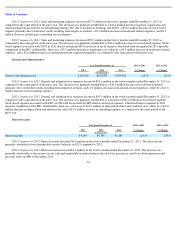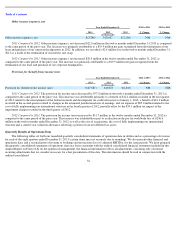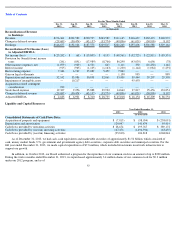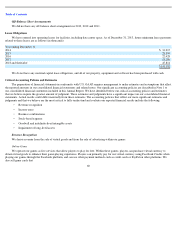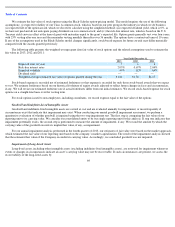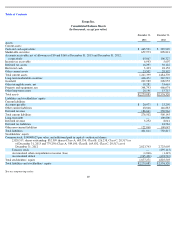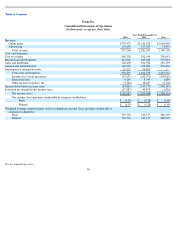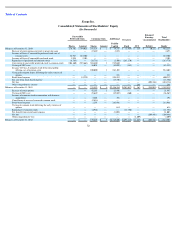Zynga 2013 Annual Report Download - page 66
Download and view the complete annual report
Please find page 66 of the 2013 Zynga annual report below. You can navigate through the pages in the report by either clicking on the pages listed below, or by using the keyword search tool below to find specific information within the annual report.
Table of Contents
average the time periods from first purchase date and the date the last player is expected to cease playing the game for each of the monthly
cohorts to determine the total playing period for that game. To determine the estimated average playing period we then divide this total playing
period by two. The use of this “average” approach is supported by our observations that paying players typically become inactive at a relatively
consistent rate for our games. If future data indicates paying players do not become inactive at a relatively consistent rate, we will modify our
calculations accordingly. When a new game is launched and only a limited period of paying player data is available for our analysis, then we
also consider other factors, such as the estimated average playing period for other recently launched games with similar characteristics, to
determine the estimated average playing period.
From July 2010 through September 2013, Facebook’s proprietary virtual currency, Facebook Credits, was the primary in-game payment
method for our games on the Facebook platform. Under the terms of our agreement, Facebook set the price our players pay for Facebook Credits
and collected the funds from the sale of Facebook Credits. Facebook’
s stated face value of a Facebook Credit is $0.10. For each Facebook Credit
purchased by our players and redeemed in our games, Facebook remits to us $0.07, which is the amount we recognize as revenue. We recognize
revenue net of the amounts retained by Facebook related to Facebook Credits transactions because we do not set the pricing of Facebook Credits
sold to the players of our games.
In July 2013, Facebook began to transition payments made on the Facebook platform from Facebook Credits to Facebook’s local currency-
based payments program. This transition was completed in the fourth quarter of 2013. Under the terms of our agreement, Facebook remits to us
70% of the price we request to be charged to the game player for each transaction. We continue to recognize revenue net of the amounts retained
by Facebook related to Facebook local currency-based payments because Facebook may choose to alter our recommended price, for example by
offering a discount or other incentives to players playing on their platform. Additionally we do not receive information from Facebook indicating
the amount of such discounts offered to our paying players or regarding the actual cash paid by our players to Facebook. Accordingly, we are
unable to determine the gross amount paid by our players to Facebook. Prior to the implementation of Facebook Credits in our games, players
could purchase our virtual goods through various widely accepted payment methods offered in the games and we recognized revenue based on
the transaction price paid by the player.
We estimate chargebacks from Facebook and our third-party payment processors to account for potential future chargebacks based on
historical data and record such amounts as a reduction of revenue.
Advertising
We have contractual relationships with agencies, brokers and certain advertisers for advertisements within our games. We recognize
advertising revenue as advertisements are delivered to customers as long as evidence of the arrangement exists (executed contract), the price is
fixed and determinable, and we have assessed collectability as reasonably assured. Certain branded virtual goods and sponsorships are deferred
and recognized over the estimated average life of the branded virtual good or as the branded virtual good is consumed, similar to online game
revenue.
We generally report our advertising revenue net of amounts due to advertising agencies and brokers because we are not the primary obligor
in our arrangements, we do not set the pricing, and we do not establish or maintain the relationship with the advertiser. Certain advertising
arrangements that are directly between us and end advertisers are recognized gross equal to the price paid to us by the end advertiser since we are
the primary obligor and we determine the price.
Income Taxes
We account for income taxes using an asset and liability approach, which requires the recognition of taxes payable or refundable for the
current year and deferred tax liabilities and assets for the future tax consequences of
62



